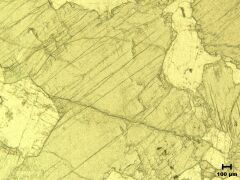Hypersthène = orthopyroxène
GALERIE D'IMAGES
HISTOIRE
INVENTEUR
–
ÉTYMOLOGIE
–
CRISTALLOCHIMIE
FORMULE
(Mg,Fe2+)2Si2O6
CRISTALLOCHIMIE
solution solide Enstatite – Ferrosilite
SYSTÈME CRISTALLIN
SYSTÈME
Orthorhombique
MAILLE
a=18,2 ; b=8,83 ; c=5,2
MACRO
ASPECT DES CRISTAUX
Granulaire
COULEUR
Blanc grisâtre, blanc verdâtre, blanc jaunâtre, noir grisâtre. Trace blanc grisâtre, verdâtre
DENSITÉ
3,2-3,9
DURETÉ
5,5-6
ÉCLAT
Vitreux
ASPECT
ROCHES PLUTONIQUES
Dans les granites à hypersthène (charnockite), gabbros à hypersthène (norites et gabbronorites)
ROCHES VOLCANIQUES
Difficile à voir dans les andésites
ROCHES MÉTAMORPHIQUES
Dans les granulites
ROCHES SÉDIMENTAIRES
–
GISEMENTS
Se rencontre dans certains granites (charnockites) et gabbros (norites). Egalement dans certaines laves avec l’augite (andésites). C’est un minéral caractéristique des faciès profonds de métamorphisme
PROPRIÉTÉS OPTIQUES
ELLIPSOÏDE DES INDICES
Ng=1,702-1,727 ; Nm=1,699-1,725 ; Np=1,690-1,710
LNPA
Faiblemant coloré (verdâtre, jaunâtre, brunâtre), section transversale montrant deux clivages suborthogonaux
LPA
Teinte de biréfringence du 1er ordre (jaune orangé), δ=0,012-0,016. Extinction droite, allongement positif
LC
Biaxe négatif, 2V=45-70°
CLASSIFICATION
CLASSE
9. SILICATES
SOUS-CLASSE
9.D Inosilicates [Si2O6]4-…-2 Chaînes
NIVEAU 3
9.DE Pyroxènes et Pyroxènoïdes orthorombiques
GROUPE
9.DE.10 Enstatite Grp
NUMÉRO
9.DE.10 Enstatite Grp

